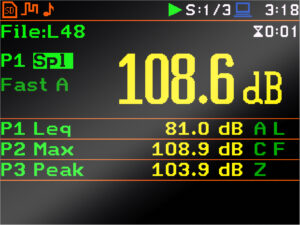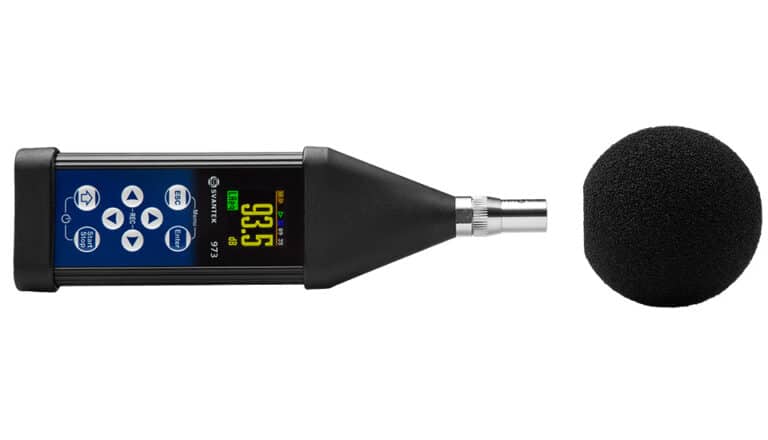There are as many different ways to measure decibels as there are decibel indicators. The most popular indicators are SPL, LEQ, and PEAK, depending on the noise measurements.
The decibel (dB) is a relative unit of measurement used to express the magnitude of a physical quantity (usually power, intensity, or sound pressure) in relation to a specified or implied reference level. Because it’s a logarithmic unit, each decibel value represents a ratio between the quantity being measured and a reference value. Therefore, when we refer to measurements in decibels, we often use the term ‘level’ to emphasize that the measurement is relative to a reference level.

Noise is measured in decibels because it provides a consistent method to represent the wide spectrum of sound pressures we encounter. The decibel, employing a logarithmic scale, compresses the extensive range of these sound pressures into a more manageable set of numbers. This makes it practical to quantify, differentiate, and compare varying sound levels in diverse contexts.
The 85 decibels (dB) value is one of the limits for daily exposure levels established by the European Noise Directive to protect workers from potential hearing damage. The Directive sets different levels, including 80 dB, 85 dB, and 87 dB, with specific actions required at each threshold to ensure workers’ hearing safety.
The sound pressure level (SPL) in decibels is a measure of the intensity of a sound relative to a reference value. Specifically, it is calibrated against a reference level of 0.00002 Pascals (20 µPa), which is the threshold of human hearing. This reference represents the quietest sound that the average human ear can perceive. By expressing sound pressure in this way, we can effectively quantify and compare the loudness of different sounds.
A frequency-weighted SPL is a measure of sound pressure levels that considers the sensitivity of the human ear to different frequencies. When measuring sound, various frequency weighting filters, such as A, B, or C, are applied to account for the ear’s varying sensitivity across the frequency spectrum. The most common filter, A-weighting, approximates the human ear’s response at moderate sound levels. Sound level meters use these weightings, and while all sound level meters must have A-weighting as a minimum requirement, class 1 sound level meters are equipped to measure with C-weighting as well, allowing for a broader range of sound frequency analyses.
A time-weighted sound level is a measurement that takes into account the variations in sound levels over a specified period of time. This is achieved by applying different time constants such as FAST, SLOW, or IMPULSE to the sound measurements, allowing the instrument to respond to rapid fluctuations in noise levels. For instance, when the SLOW time constant is selected, the display on the sound level meter will react more gradually to changing noise levels, providing a smoothed representation. Common indicators used to represent time-weighted sound levels include LAF (L- level, A-weighing, F-Fast), LAS, LCS, and LCF. These symbols help to specify the type of weighting applied, both in terms of frequency and time.
The equivalent continuous sound level, denoted as LEQ, is a measure used in acoustics to describe the overall noise level during a specified period of time. It provides a single decibel value that represents the constant sound level possessing the same sound energy as the fluctuating noise being measured. The LEQ is essential because it captures the cumulative exposure to noise, accounting for both its intensity and duration. In line with IEC 61672-1, the calculation of the LEQ does not incorporate any time-weighting, such as Fast or Slow, but rather focuses on the energy content of the noise across the entire measurement period.
LAeq,T is the equivalent continuous A-weighted sound level measured over a specified period of time, T. It represents the average noise level during that time period, taking into account the varying noise levels and their durations. The “A-weighting” applied to the sound levels mimics the frequency response of the human ear, focusing on frequencies where the ear is most sensitive. This makes LAeq,T a useful metric in assessing human exposure to noise, as it considers both the duration and intensity of noise, adjusted for the ear’s sensitivity.
PEAK refers to the maximum amplitude value of a signal within a given period, T. It captures the highest instantaneous value of the sound pressure, regardless of its duration. This is especially important in scenarios where sudden, brief sound bursts could be harmful, even if they are very short-lived.
LCpeak represents the maximum amplitude value of a noise signal when measured with C-weighting. C-weighting is chosen for peak measurements because it captures low-frequency noise more effectively than A-weighting. The peak value is not time-averaged, instead, it captures the absolute highest level of noise at any given moment within the measurement period.
Yes, you can measure decibels using a sound level meter. Specifically, an IEC 61672 Class 2 sound level meter is equipped to measure at least the frequency-weighted A and Fast time-weighted sound level LAF, along with the time-averaged sound level LAeq. For more advanced measurements, Class 1 sound level meters are designed to also measure the C-weighted LCpeak at the very least.
A sound level meter can measure various sound parameters. Specifically, Class 2 sound level meters like the SV 973 and Class 1 sound level meters like the SV 971A exceed the minimal requirements of IEC 61672. These devices are capable of simultaneously recording the LEQ, PEAK, MAX, and MIN with A, C, and Z weightings, ensuring comprehensive noise assessment without additional adjustments.

Choosing the best sound level meter depends on your specific requirements and intended use. For professional sound pressure measurements, it’s essential to follow standardized procedures that dictate the type of meter needed. Familiarize yourself with these standards to select a suitable device. However, if you’re measuring noise for personal interests or basic applications, a mobile application might suffice instead of purchasing a dedicated decibel level meter. Always consider the accuracy, features, and reliability of the device or application in relation to your needs.